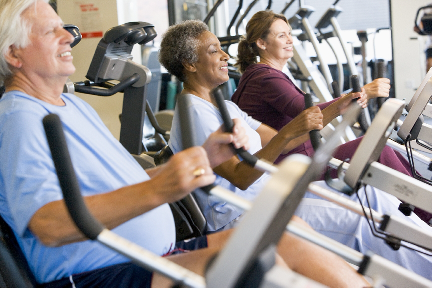This blog was written by Penny Pohlmann, MS. Meet our blogging fitness specialists at the NIFS website.
 Pain, swelling, and stiffness associated with arthritis do not make physical activity fun or easy. Research has shown, however, that exercise is a vital tool for managing discomfort associated with arthritis.
Pain, swelling, and stiffness associated with arthritis do not make physical activity fun or easy. Research has shown, however, that exercise is a vital tool for managing discomfort associated with arthritis.
In fact, avoiding exercise can increase joint pain and stiffness as the supporting muscles get weaker. By moving and using the muscles, bones, and other tissues that surround joints, people who suffer from arthritis can expect to protect themselves from further damage and pain.
Activity such as weight training promotes joint strength and stability, while aerobic exercise can help keep body weight down, which also relieves pressure on joints. Stretching exercises are useful for maintaining joint range of motion.
Arthritis is a leading cause of physical disability in the U.S., and people who are obese and physically inactive are at higher risk for developing this chronic condition. As our aging population grows, the need for senior fitness programming and management for this group does, too. Qualified health and fitness professionals can guide senior members or residents through a safe and effective exercise program designed to improve strength, reduce pain, and maintain the function of joints among arthritis sufferers.

 As the first wave of baby boomers are turning 65 this year, there is a rush to the finish line in the technology field to see who can come up with the best ideas to keep elders healthy, happy, and in their own homes.
As the first wave of baby boomers are turning 65 this year, there is a rush to the finish line in the technology field to see who can come up with the best ideas to keep elders healthy, happy, and in their own homes. With the elderly population only increasing, many senior living fitness centers are looking outside the box for ways to keep their residents moving and their spirits high.
With the elderly population only increasing, many senior living fitness centers are looking outside the box for ways to keep their residents moving and their spirits high.  New Study Offers Parkinson's Prevention Hope
New Study Offers Parkinson's Prevention Hope


 ependence. Regular strength training can help them do this from a physical standpoint, but maintaining their cognitive abilities is equally important. Interestingly enough, a loss in cognitive abilities is a risk factor for falls.
ependence. Regular strength training can help them do this from a physical standpoint, but maintaining their cognitive abilities is equally important. Interestingly enough, a loss in cognitive abilities is a risk factor for falls.